Family cemeteries scattered across Kentucky offer a window to the past. Can they survive?
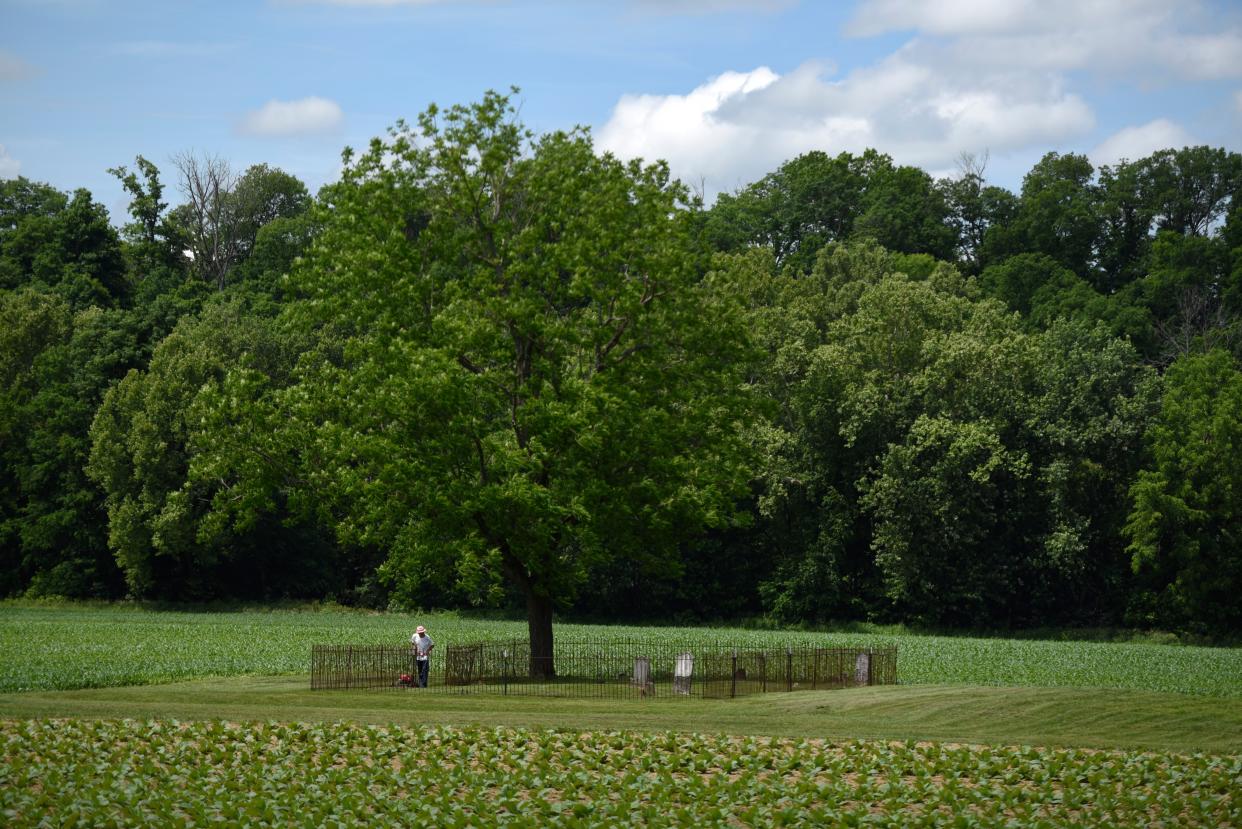
- Oops!Something went wrong.Please try again later.
CYNTHIANA, Ky. — Jim Swinford doesn’t know where Elisha is buried.
He didn’t even know Elisha existed until he was in his 20s. He first heard the name at a family reunion in the 1960s and learned Elisha Swinford was his great-great-great-grandfather.
He was told Elisha moved to the United States from England and married a woman named Thankful. And he had lived only 30 minutes from Swinford’s Cynthiana home.
As the family reunion was winding down, the family piled into their cars and drove over the rolling hills to Elisha’s old farm.
A gravel driveway led them to a grassy area in the middle of cornfields stretching to the South Fork Licking River. And there, in the shade of an oak tree, was the Swinford family cemetery.
It was a mess.
A stack of irrigation pipes, with bees humming loudly inside, blocked the gate on the iron fence bordering the site. Grass had grown over many of the tombstones, but they managed to count 18 in all. Many were green and weathered, hardly clear enough to read, but the family made out three names: Julia Swinford, William Swinford, and their daughter, Sarah.
More:Ever wonder about those giant photos on Louisville buildings? Here's who's up there and why
No sign of Elisha’s grave, though.
Still, Swinford made a connection with his past that afternoon, one that guides him to this day.
The Swinford family cemetery is one of hundreds in Harrison County and across Kentucky.
Some are hidden behind barns, some prominently placed in front of homes. Others are tucked into quiet forests that were once active farms or churchyards.
Without tending, the old stones can sink deep into the ground, burying the names of the dead. Others topple over, only to be reclaimed by weeds or cracked by grazing cattle.
Trend toward cremation leaving cemeteries behind
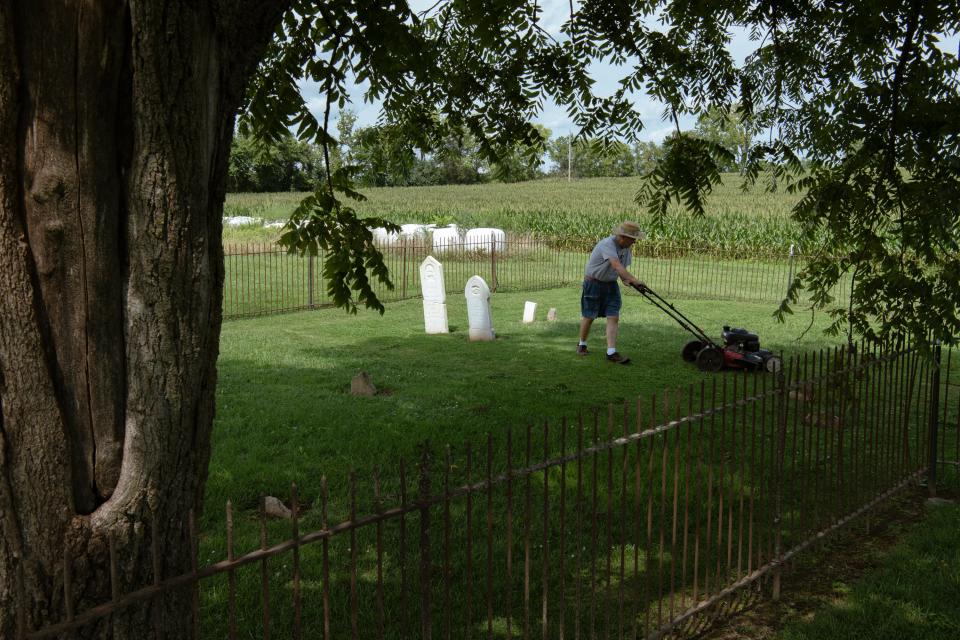
In early America, family cemeteries were not just common, they were essential. As people died from childbirth, sickness and wars, they were laid to rest on the farm, where family members could care for their graves.
But as people started to move into cities for factory jobs, they needed new places to bury their dead. Mass public cemeteries answered the call.
First, graves were dug in the middle of cities, but with cholera and yellow fever epidemics, residents worried the crowded burial sites would spread disease. They began to bury people on sprawling land outside city centers, starting the trend of large suburban cemeteries.
Now, Americans are moving away from burials altogether. The total number of cremations surpassed burials in 2015, and six years later, nearly 60% of Americans who died were cremated, according to the Cremation Association of North America.
The National Funeral Directors Association estimates that by 2040, nearly 80% of Americans will choose cremation.
“Half the people have to do it. Half the people want to do it,” said Brent Gaunce of Drake Whaley McCarty Funeral Home in Cynthiana. “If a person died today and had to pay for a grave and having it dug, it would be $2,200. So that’s why some people can’t afford it.”
That national trend toward cremation means cemeteries — family or otherwise — aren’t as essential as they once were.
You may also like:The Gray Lady has haunted this house for 200 years. Is she Kentucky's oldest ghost?
Documenting the past
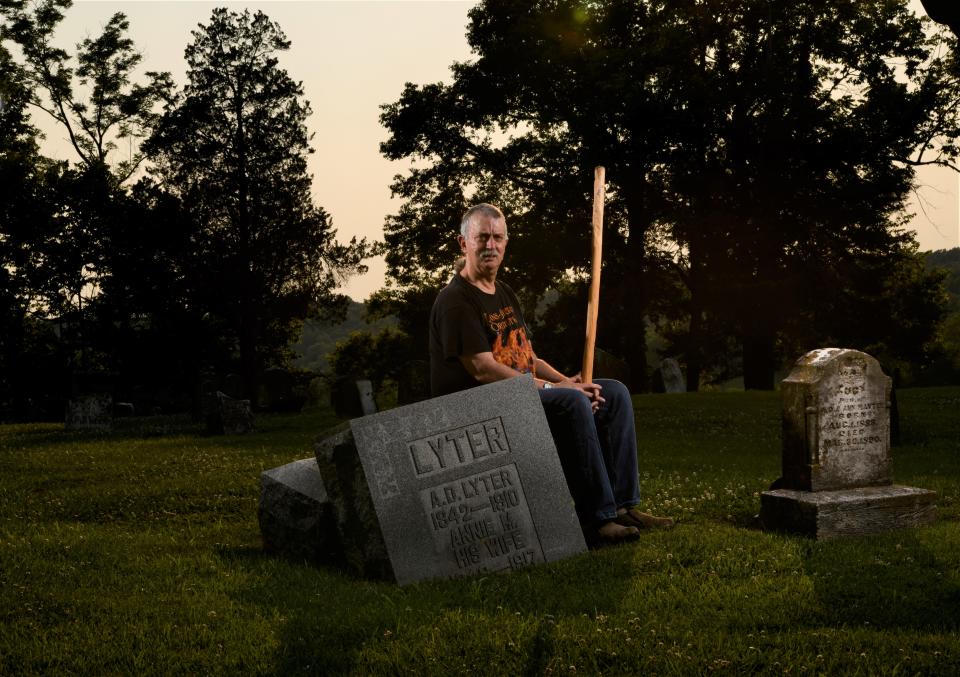
There are a few options for preserving family cemeteries, but each has its limitations:
The Kentucky Preservation Fund helps maintain the commonwealth’s historical sites, but only nonprofit organizations, churches and government agencies can apply for funding.
The Kentucky Historical Society has an Adopt-a-Cemetery program, but it says communities are “more likely” to receive funding if they have a county cemetery preservation board.
The Kentucky Heritage Council helps people find funding to preserve family cemeteries, but their website says “many preservation grant funds have been depleted.”
“One of these days, these are going to be gone,” said Denny Lipscombe, a local historian who researches cemeteries in Harrison County. “And there needs to be some kind of documentation that these are here.”
It’s become Lipscombe’s mission. He’s been to 165 cemeteries in the county, with about 35 still left to find.
He first started with an idea to write a book about Harrison County’s history. As he visited old houses, people would tell him about their family cemeteries or gravestones they remembered from childhood.
“That started getting in my head,” said Lipscombe, 65, “and then it took over my head.”
In the colder months, when the brush and weeds have died down, Lipscombe searches for grave markers.
When he finds them, he takes pictures of every tombstone from all angles.
More:From sunglasses to a painted fly swatter, 10 unique items left on Muhammad Ali's grave
Lipscombe also runs two Facebook pages called “Gone But Not Forgotten”and “Take Me Home, to Cynthiana” where he posts pictures of cemeteries, as well as historic documents and photographs. Many people leave comments, looking for the graves of their relatives, and asking Lipscombe if he’s seen them.
Odds are, he has.
Sitting in front of his computer, Lipscombe can sort through files of each picture he’s taken, organized by cemetery. With his cat, Avi, sitting on a box of genealogy documents tucked under his desk, he can usually find a specific gravestone in minutes. He can even pull up GPS coordinates.
“This is who we are,” Lipscombe said. “Was this country founded by George Washington and Thomas Jefferson, or by the people who did the farming? And can you name one of those people who did the farm work?”
Nature — and vandalism — take a toll on family cemeteries
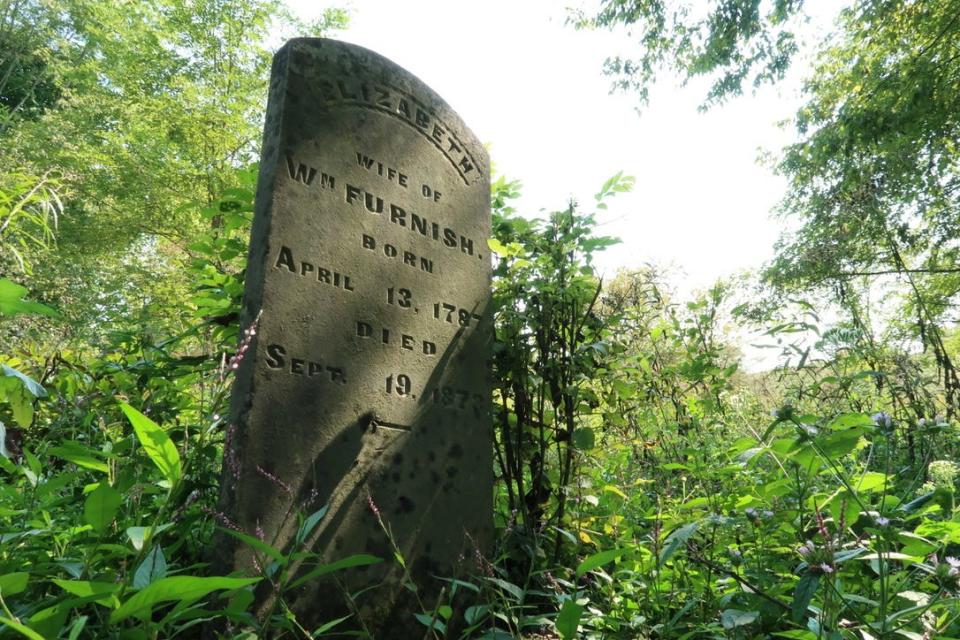
On a gray afternoon earlier this year, Lipscombe drove down a winding Harrison County back road that dead-ended at a 19th-century brick house. The windows were boarded up, and vines crept over its walls.
About 200 feet behind the house, a cemetery sat hidden behind a wall of trees. A few of the stones were chipped, making the inscriptions impossible to read. Some were covered in vegetation. Others had fallen to the ground.
At the front of the cemetery, a stone sat broken. The break was clean and new, with its white interior stark against more than a century of dirt.
“What has somebody done? That’s a new break,” Lipscombe said. “I hate that. Who would come all the way back here to do that?”
Still, though, the Adams cemetery, as it’s known, is peaceful for Lipscombe.
“I could just come out here and stay all day,” he said, looking toward the abandoned house. “I always said if I won the Powerball, I would buy this.”
Seven miles away, the Tebbs family cemetery is also falling apart.
Three sisters inherited the farm off Connersville Pike after their parents died in the early 1900s. Since none were married, they decided to sell the farm and run a boarding house in downtown Cynthiana instead. To protect the family gravestones, the sisters placed each of them flat on the ground, covered the entire plot with concrete and erected one tall marker that lists all the people buried there.
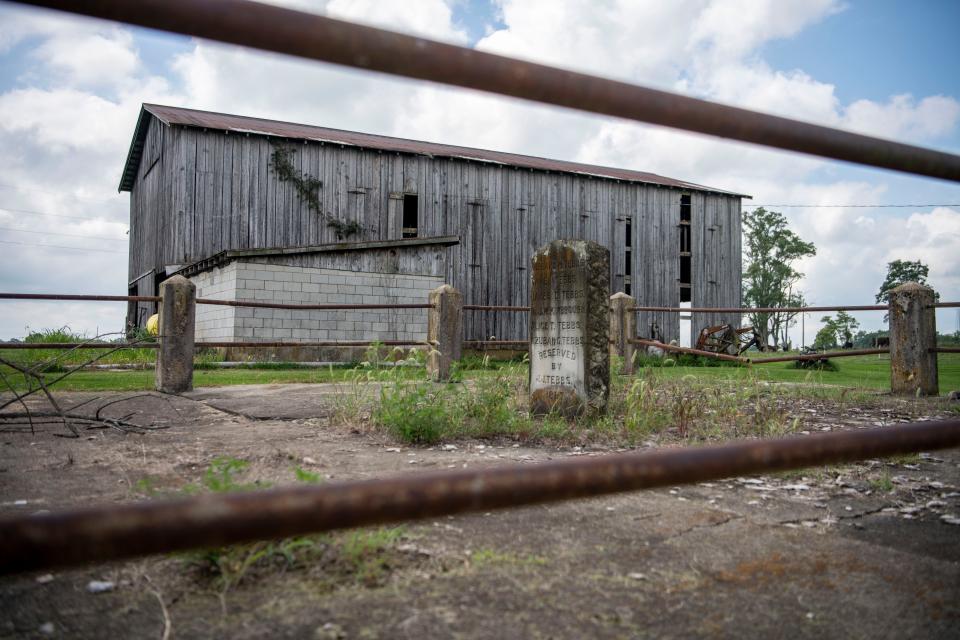
“They were leaving, and it was their way of tucking it into sleep forever,” said Marie Copeland, a Tebbs family descendant.
While her mother was still alive, Copeland would drive them an hour away from their homes to see the marker. She’s also taken her grandkids a few times.
But now, she’s 81, and the concrete at the cemetery is cracking as weeds break through. She expects bulldozers will come one day to make the land into a subdivision.
“It’s OK,” Copeland said. “Personally, I don’t think you should lock up land forever and ever.”
‘You can’t ignore them; you just can’t’
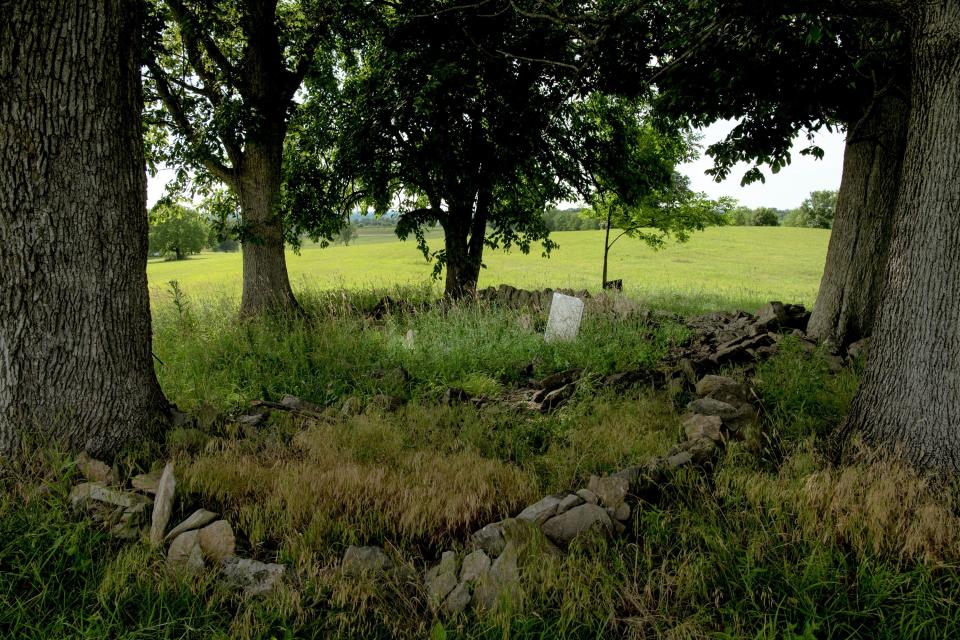
By 1860, over 200,000 women, men, and children were enslaved in Kentucky. But their final resting places have been mostly neglected.
In Harrison County, slave cemeteries are recalled only by rumor, if they’re remembered at all.
Even Lipscombe, with all his cemetery records, can only point out the car window to places where he’s heard slaves were buried.
Some burials were marked with engraved field stones or wooden crosses, which have since disappeared.
But deep in a bed of ivy off Connersville Pike lies the grave of Enoch Boyers.
Related:A new project is shedding light on Black Civil War vets — and reconnecting them to their families
Boyers was born into slavery on Nov. 9, 1839, at a time when an estimated 6,000 slaves per year were being sold out of Kentucky to southern states. He died 16 years after the Civil War at age 42.
Years after Boyers died and was buried on the side of a hill, his former enslaver sold the plot of land to an African American Methodist Episcopal Church for $100.
The deed dictated the land would be sacred, used to bury only Black residents of the community.
Now, with the church gone, the cemetery rests in an unmarked clump of trees in the middle of a field.
Many of the stones have sunk so deep, they can’t be read. Others are crumbling, but Enoch Boyers’ marker, with a Bible carved into the stone, sits next to a tree.
Finding and documenting those long-lost Black cemeteries has become a mission for Yvonne Giles. The local historian has struggled for 20 years to find any documentation of the plots scattered around the state.
So far, she’s been able to find four families related to her who had been enslaved. By discovering their names and death dates based on their tombstones, she could track when they were emancipated, who they married and how many kids they had.
But in many cemeteries, like the one holding Enoch Boyers, there’s little to find.
"When I discovered that our Black cemetery had never been recorded, I got mad. I thought, 'What is this? They can record every little family grave site everywhere, but not these Black ones?'" Giles said. "... You can't ignore them; you just can't."
‘I found out there’s all those veterans’
Even if a cemetery is found, figuring out who owns it can be a challenge.
When Shayne Currans first moved to his new house in Leesburg, his realty agent told him there was a cemetery across the street, but he didn’t know who owned the land.
Currans found the cemetery covered with thick trees and high grass, and discovered a recurring theme on the gravestones: Ira Black, World War I; Charles H. Brent, World War II…
“I found out there’s all those veterans,” Currans said, “and I wanted it cleaned up because I’m a vet myself.”
For two years, Currans mowed around the veterans’ graves and adorned them with flags, but he wanted to learn more. At the county courthouse, he found a deed to the property saying the cemetery was sold by a church in 1915 for $100 to the Harrison County Board of Education.
Opinion:Veterans need more than our thanks. They need our active support and assistance
Robert Switzer, director of pupil personnel for the school board, remembers when Currans brought him the news.
“I’m very confused. And he can see the look on my face,” Switzer recalled. “We’re a public school. We don’t own a cemetery.”
Then Switzer saw the deed.
“Sure enough,” he said, “we own a cemetery.”
Switzer immediately added the cemetery to the mowing list of school board properties. The trees were cut down, the grass was mowed. And nobody was more excited than Alice Brent.
The 83-year-old once put an advertisement in the newspaper asking for donations to maintain the cemetery, where most of her family is buried. It used to be attached to a church. Her father dug its graves. Her mother sold produce from their garden to pay for the upkeep.
But after the church was razed and her parents died, she couldn’t take care of it herself.
It became so overgrown that Brent couldn’t visit her mother’s grave. When two of her sisters died during that time, they both had to be buried in a different cemetery because the weeds were too tall.
But now, Brent and her sons can visit her mother easily.
“When my mother had that cemetery, it looked beautiful,” Brent said. “And it looks beautiful now.”
‘I stand on their shoulders’
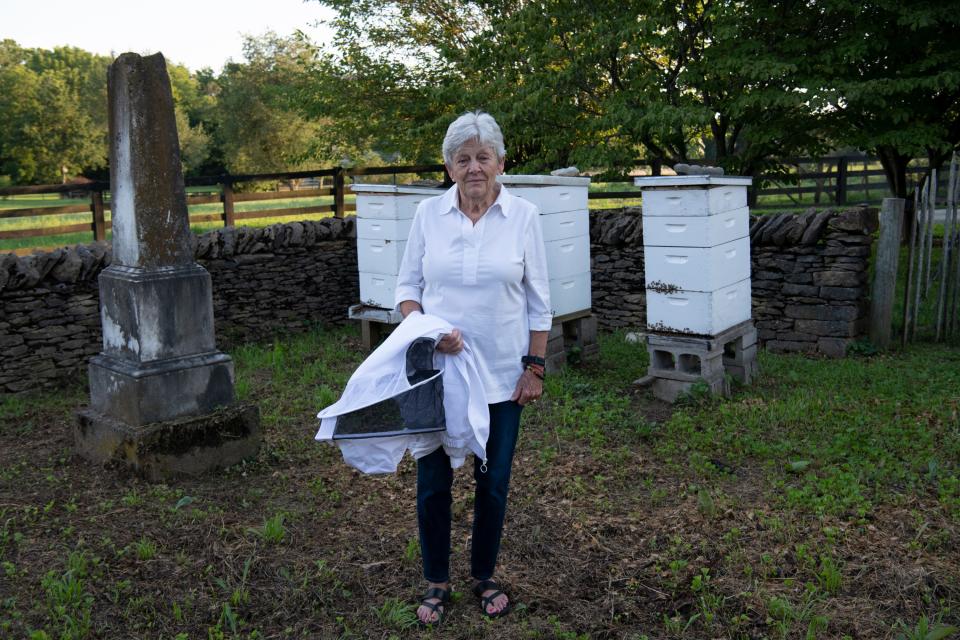
Several years after learning of his connection to Elisha, Jim Swinford hired three neighbors to clear the shoulder-tall weeds in the cemetery. The farmer who owned the land used his equipment to fill depressions in the ground where the old coffins settled.
Swinford, then in his 30s, straightened each stone. He bought a safe chemical cleaner and sprayed the stones of Julia, William and Sarah. Soon, their names could be easily read.
He began searching for documents at the courthouse to learn more. He found no records about his family cemetery, but he did find an inquest for Elisha Swinford from 1813.
It concluded he took his own life. The court records called the suicide “ungodly.”
The mystery of Elisha’s burial grew deeper. Swinford wondered whether Elisha was not allowed to be buried with his family. Or maybe he was buried there in an unmarked grave.
Swinford began carefully trimming the grass around the gravestones and clearing the weeds each week. The cemetery was alive again.
You may also like:How this family's bar tells the story of a father's resilience in World War II
Jane Thomas felt the same call to restore her family cemetery when she moved back to Harrison County in 1993.
She returned home to care for her sick father, but ended up tending the family cemetery, as well. She hired people to clear the weeds and to replace the dilapidated wooden fence with a stone wall. And then she had an idea.
Thomas remembered her grandfather had once kept bees to make honey. She decided to start the practice again.
Against the stone wall, mingled with the gravestones, Thomas put six tall, white boxes of beehives. When she cares for the bees, she sometimes leans down to read the inscriptions on the grave markers.
“There’s a feeling of completion. Like full circle, maybe,” Thomas said. “And I never stop thinking about the fact that I stand on their shoulders. What they went through, and what they endured, and what they did, made it possible for me to be.”
Thomas sells her honey at local markets and stores. On the front of each glass bottle is a label with a drawing of the family cemetery and her company name: Honey to Die For.
New family cemeteries
Gaunce, of the Cynthiana funeral home, said in a few cases, “family cemeteries are making a bit of a comeback.”
Sometimes it’s just too expensive to be buried in a public cemetery. Some like having complete control over how they can decorate and visit the graves.
“Three weeks ago, I buried a lady in her sister’s backyard,” Gaunce said. “Literally. It’s not a cemetery. It’s her backyard.”
In 2010, Debbie and Mike Ammerman moved the body of Debbie’s mother to a quiet spot on their farm overlooking the South Fork Licking River. Hedges surround a sleek black tombstone and a gray mausoleum. A statue of Jesus stands on a ledge near the front.
“I guess I’ll be buried here, and my husband,” Debbie said “Because it’s home. That’s where we’re all going. You got the river, you got the trees, you’re on the farm.”
Most people, though, are still choosing to be buried in public cemeteries or to be cremated. Even Denny Lipscombe, with his mission to document family cemeteries, isn’t planning to be buried in one.
“There is enough in the ground. We don’t need any more,” Lipscombe said. “I’m going to be burnt, and my ashes will be buried at Colemansville church, only because I like the view there.”
Lipscombe has already decided on the epithet for his marker: The Dead Man’s Best Friend.
No one visits anymore
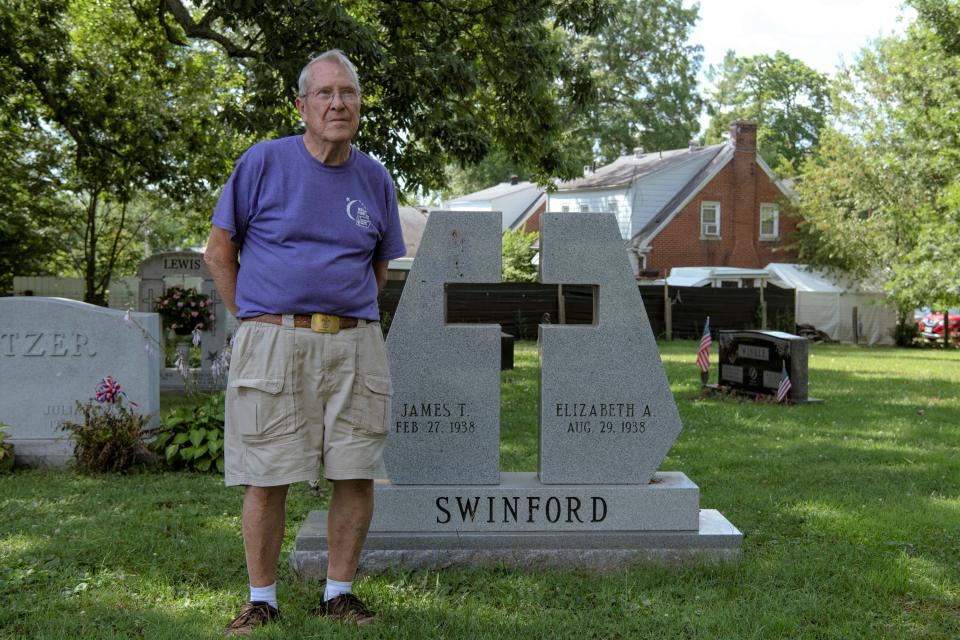
Now 84, Swinford continues to take care of his family cemetery. He mows it every week, hitching a trailer to the back of his car to tug along his two mowers. His wife worries about him when he goes alone.
But he often goes alone, mostly because he has to. His cousins, aunts and uncles have died, and there are no more Swinford family reunions. No one visits the cemetery.
“It’s mostly just me,” Swinford said.
When Swinford looks around the cemetery, he still sees what needs to be fixed. Dead tree limbs will soon have to be cut down. The fence will need to be replaced.
“But I don’t know who’s going to do it,” he said. “I’ve got a son, and he works at 3M (a nearby factory). He’s got 18 acres out in the country, and he spends a lot of time keeping it mowed. And he’s got two daughters. So, I don’t know of anybody else that’s interested here.”
Swinford has labored for years to revive and maintain the family cemetery, but he’s already decided he won’t be buried there. When it’s time, Swinford’s remains will rest in Cynthiana’s largest public cemetery. He already has his stone up. The empty space between his marker and his wife’s marker form a cross.
But Swinford doesn’t want a regular burial.
“I’m going to be cremated,” he said. “I see the caskets in the vault go down in the ground. I said, ‘You know, it’s such a waste.’”
This article is part of a collaboration between The Courier Journal and Boyd's Station, a Kentucky non-profit that provides emerging artists and student journalists a rural place to hone their craft. Sarah Hume was the recipient of the 2022 Mary Withers Rural Writing Fellowship grant at Boyd's Station.
This article originally appeared on Louisville Courier Journal: Kentucky family cemeteries offer a link to the past. Can they survive?

